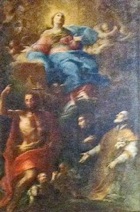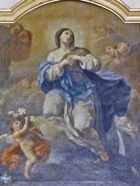

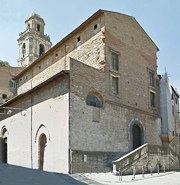
The parish church of Santa Maria di Porta Sole was documented here in 1285.
Sylvestrines
The Sylvestrines first moved here in 1293 from their monastery of San Benedetto (now Sant' Erminio). Fire destroyed much of the complex during the riots attending the destruction of the Fortezza di Porta Sole in 1376, at which point the Sylvestrines moved to San Fortunato.
Some of the Sylvestrines returned to what was left of their monastery in 1404 and rebuilt the church in 1406. The Commune subsidised the construction and instituted an annual procession there of the feast of St Ambrose, the date at which the papal legate Girardo di Puy, the Abbot of Monmaggiore had been driven from the city. This church, which stood on the site of the present apse and transept, was known as Santa Maria Nuova.
The monks transferred the relics of the Blessed Paolino Bigazzini (who had been born in Perugia) to the new church from the derelict Monastero dei SS Marco e Lucia del Sambuco, near Gubbio at some time in the 15th century, which led to an upsurge of the cult.
The complex passed to the Servites (see below) in ca. 1540, at which point its Sylvestrines re-joined their colleagues at San Fortunato.
Servites
In 1540, the complex passed to the Servites from the demolished church of Santa Maria dei Servi, and they rebuilt the church on a larger scale. They brought with them many works of art and also the patronage of a large number of important Perugian families and confraternities.
From 1634, when the Confraternita di San Giovanni Battista moved to its own oratory, the nearby Oratorio di San Giovanni Battista, the consecrated Host was taken in procession each year on the feast of St John the Baptist (24th June) from their oratory to Santa Maria Nuova and Sant’ Antonio Abate.
The church was restored in 1895, in 1913-6 and in 1961, when the apsidal chapels were re-opened.
The Servites left Perugia in 1998. The convent has been adapted as apartments, but the church is still occasionally open for services.
Exterior
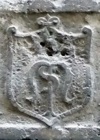
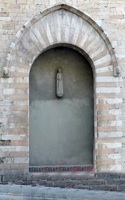
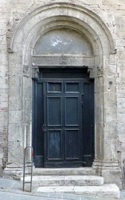
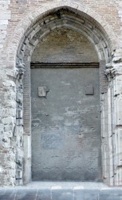
The Gothic portal in red and white marble in the wall in Via del Roscetto is possible from the first church here. The two closed arches to the right of it survive from the original Santa Maria Nuova (1406). The middle portal has the arms of the Servite Order on its architrave.
The fountain (1568), at the base of the double staircase that leads to the façade, was restored in 1722.
The distinctive campanile (1644) was built to a design (16th century) that is attributed to Galeazzo Alessi.
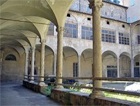
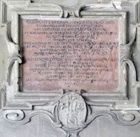
Interior
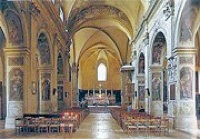
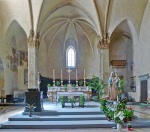
The church has a wide central nave and two aisles. Traces of the original Santa Maria Nuova (1406) survive in the polygonal apse and in the two apsidal chapels.
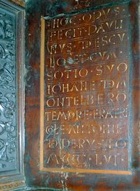
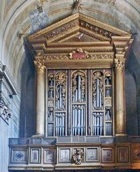
Frescoes in the Nave (17th and 18th centuries)
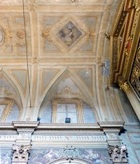
Assumption of the Virgin (18th century)
Altars on the Left
Madonna delle Grazie (15th century)
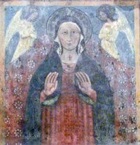
Altare di San Pellegrino (18th century)
This altar (the 1st on the left) is probably dedicated to the Servite, St Peregrine Laziosi, who was canonised in 1726.
Vision of SS Peregrine Laziosi and Juliana Falconieri (1740)
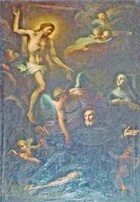
Altare dei Sette Fondatori (18th century)
This altar, which is dedicated to the seven founders of the Servite Order, belonged to the della Penna family by the 19th century.
Copy (1822) of Madonna di Loreto (1507)
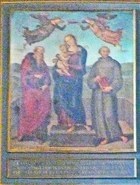
The altarpiece was moved to this altar in Santa Maria Nuova in 1540. Fabrizio della Penna bought it from the friars in 1821 for his private collection, and included this copy by Giuseppe Carattoli as part of the price. He sold the original to the National Gallery, London in 1879.
The original frame of the altarpiece was recently discovered in the deposit of the Galleria Nazionale. This confirmed the hypothesis that it only ever comprised this single panel, which depicts the standing Virgin and Child with SS Jerome and Francis.
Altare della Madonna (18th century)
Madonna and Child with saints (16th century)
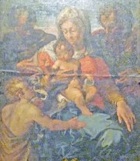
Madonna and Child with saints (1587)
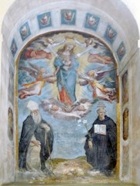
Apsidal Chapels
As noted above, these chapels at the ends of the aisles were re-opened in 1961. They contain frescoes that survive from the original church of Santa Maria Nuova.
Left Apsidal Chapel
Frescoes (15th century)
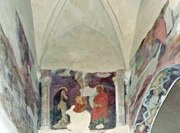
In his life of his grandfather, Lazzaro Vasari, Giorgio Vasari noted: “In Perugia, Lazzaro wrought some stories of the Madonna, with a Crucifix, in the chapel beside the sacristy of the church of the Servi”. These damaged frescoes were uncovered in the chapel at the head of the left aisle in the restoration of 1961. In fact, what Giorgio thought were scenes from the life of the Virgin are actually scenes from the life of St Catherine of Alexandria.
Crucifixion with saints (15th century)
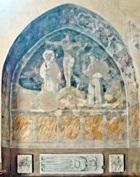
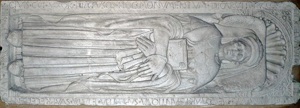
[I cannot find out anything about this fresco in the niche on the left. The monument below seems to commemorate a doctor who died in 1448].
Madonna and Child with saints (1740)
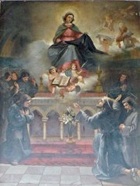
Right Apsidal Chapel
Monument to Braccio I Baglioni (1479)

The funerary monument of Braccio I Baglioni, which is now in the chapel at the head of the right aisle, probably came from Santa Maria dei Servi. This inscription beneath reads:
BRACCIO I BAGLIONI
CAPITANO GENERALE DELLA CHIESA
SIGNOR DI PERUGIA
1419-79
Fresco Fragments (15th century)
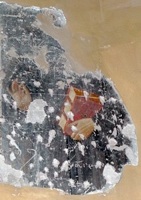
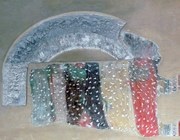

These damaged fresco fragments above the door to the right that leads to the sacristy survive from the original church of Santa Maria Nuova.
Monaldi Monuments (17th century)
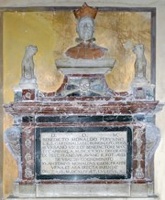
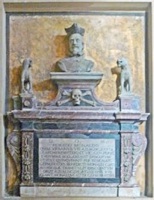
These monuments to the sides commemorate two brothers of the Monaldi Baldeschi family:
-
✴Benedetto (died 1644), Abbot of San Bevignate (to the left above), who became a cardinal in 1633 and Bishop of Perugia in 1634; and
-
✴Orazio (died 1656), who succeeded Benedetto as Bishop of Perugia in 1643.
Altars on the Right
Altare della Compagnia degli Oltremontani
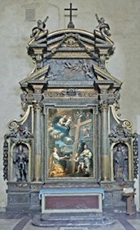
-
✴St Henry II, (who was born in Bavaria and became Holy Roman Emperor); and
-
✴St Louis IX of France.
It is a documented work by Léonard Chailleau (Leonardo Scaglia, il Francese). [The terms of the contract were disputed and he served a few days in jail as a result.]
St Helen and the Holy Cross (17th century)
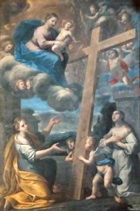
Altare dell’ Addolorata (1608)
Panels (17th century)
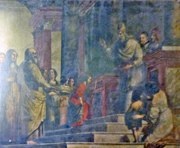
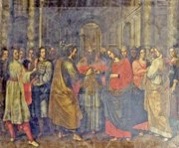
These two panels by Stefano Amadei depict:
-
✴the Presentation of the Virgin at the Temple; and
-
✴the Marriage of the Virgin.
Altare del Gonfalone
This was the funerary chapel of the Confraternita di San Benedetto.
Gonfalone di Santa Maria Nuova (1471)
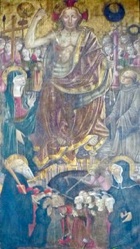
The banner depicts a majestic figure of Christ, who threatens Perugia with arrows. He is surrounded by angels carrying the instruments of the Passion, and flanked by representations of the sun and the moon. The Virgin, SS Benedict and Scholastica and the Blessed Paolino Bigazzini intercede for Perugia. The saints commend the souls of a group of kneeling men and women that includes members of the confraternity, as an angel menaces them with a lance. This scene is set against a cityscape of Porta Sole seen from outside the city wall.
Altare del Crocifisso (1600)
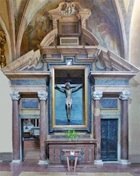
Crucifix (1471)
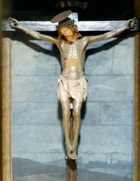
Oratorio del SS Crocifisso (1581)

This oratory, which belonged to the Confraternita del SS Crocifisso, can be reached from the church (above). It also has another entrance in Via Pinturicchio. Valentino Martelli designed both the oratory and its altar.
Deposition of Christ (1593)
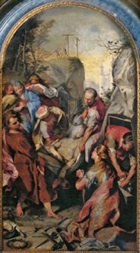
Frescoes (1750)
The frescoes in the oratory are by Pietro Carattoli and Antonio Maria Garbi.
Art from the Church
Works from this church that originated in Santa Maria dei Servi are described on the page on that church.
Panels from the polyptych of the Sylvestrines (1487-93)
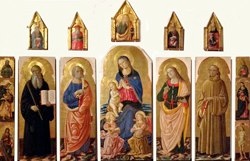
A series of three contracts between the Sylvestrines of Santa Maria Nuova and Fiorenzo di Lorenzo relate to this work:
-
✴The first, dated 1472, documents the commission of a double-sided polyptych.
-
✴The second, dated 1487, reduces the scope of the commission to a single-sided polyptych.
-
✴The third, dated 1491 (when the work seems to have been in progress), requires that the project should be completed by 1493.
This polyptych remained in the church when the Sylvestrines left in 1540. It had almost certainly been originally on the high altar, but it had been moved by the early 17th century. It was probably dismantled in 1810, when it was moved to the Accademia di Belle Arti. It is now in the Galleria Nazionale.
The original frame and the predella panels have been lost.
-
✴The five main panels depict:
-
•the Madonna and Child with two kneeling angels;
-
•St Peter;
-
•St John the Evangelist;
-
•St Benedict; and
-
•a Sylvestrine saint (St Sylvester Gozzolini or the Blessed Paolino Bigazzini, both of whom were included in the agreed scope of the work before it was reduced in 1487).
-
✴The pilasters contain figures of:
-
•a Benedictine monk, the Archangel Gabriel and St John the Baptist (on the left); and
-
•a Benedictine monk, the Virgin Annunciate and St Sebastian (on the right).
-
✴The smaller panels from the upper register contain figures of God the Father and the Doctors of the Church (SS Ambrose, Jerome, Augustine and Gregory).
Virgin in Glory with Saints (1740)
